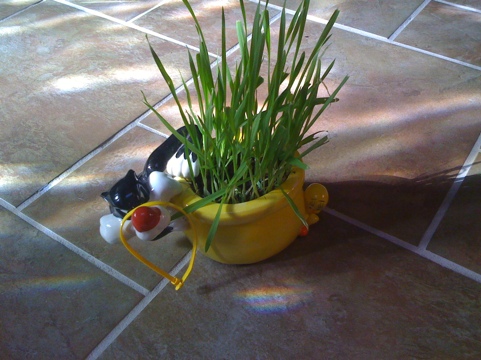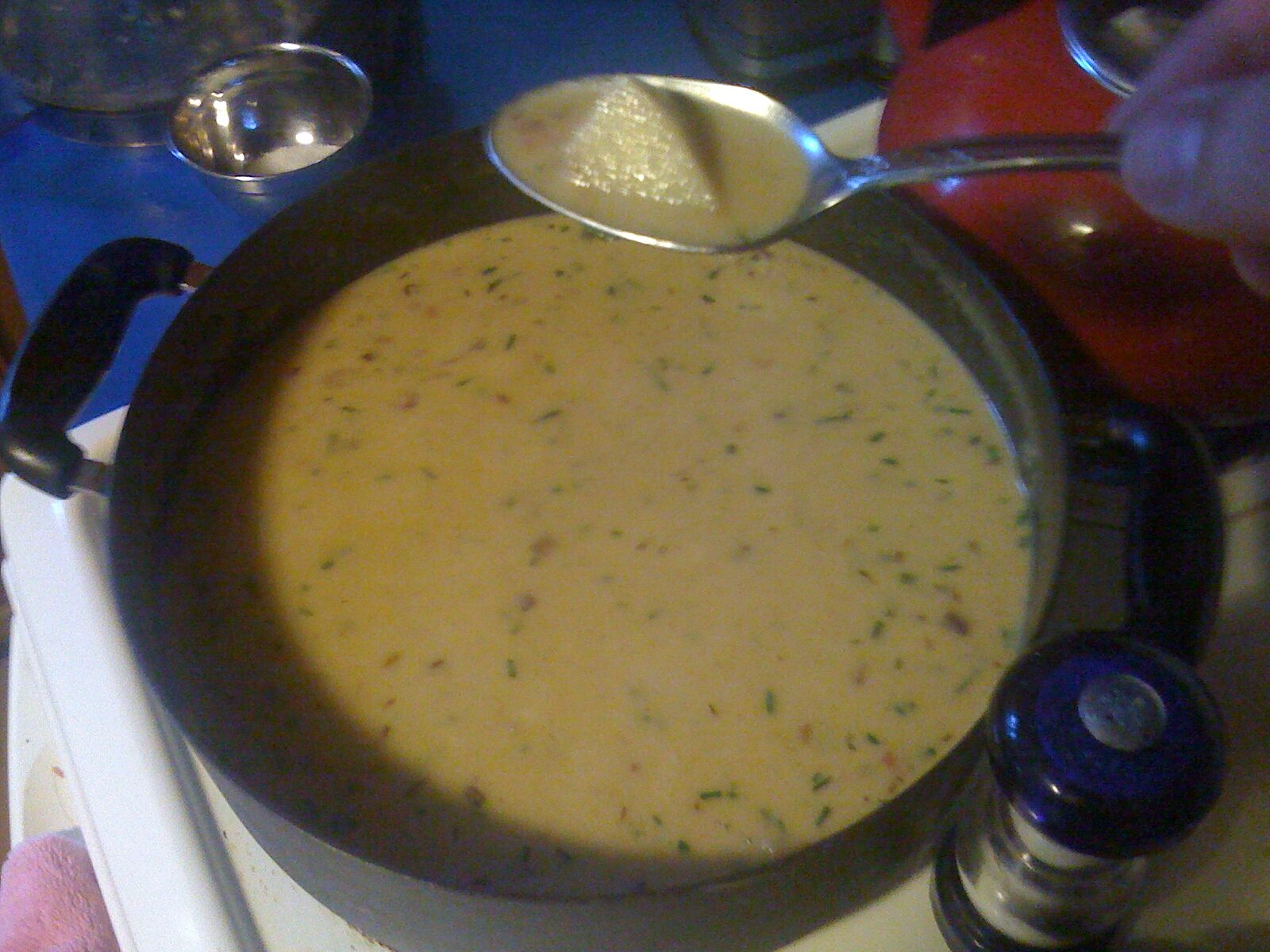Here’s some of the thinking that went behind this soup. I usually cook potatoes in the soup-stock or even separately, if I’m worried about the release of starch, but I’ve heard some talk about how alcohol actually changes some of the starch’s composition, and I wanted to see how the potatoes cooked in the beer. Amazingly well, it turns out. Above in the recipe, I say that the potatoes should cook for 20 minutes, but I have no idea how long I had them on the heat. It was longer for twenty minutes. With just water and salt, the potatoes would have broken down into mush. In this case, the alcohol was just taking the starch that the potatoes released and combined it into a funky puff of scum on top of the liquid. It didn’t look too good, but I happen to know from experience, it tastes good. Don’t be squeamish and skim it off.
Why skin on? The potatoes hold together a bit better with skin on, and the waxy potatoes have a nice tender skin when cooked. The skin is the only real action as far as flavor and nutrition in a potato, too, so wash the damned things and keep them on.
Large dice? Yeah, a little secret. It doesn’t make a lick of difference what size you cut your potatoes as long as they are consistent with each other. Make them teenie-tiny, if you want, or keep the buggers whole. Whatever. Cut them the way you like to see them in your spoon, and keep them all about the same size. They’ll cook at the same rate if they’re the same size. Anything else is pure preference. I like large chunks of vegetables in my soup, so my large dice is going to be your hunka-chunk, but go ahead and spend the time to make them all 1cm cubes, if you wish. Keep in mind though, since we’re keeping the skin on, cutting them roughly into wedges keeps some skin on almost every piece, so again, since we’re going for consistency, a rough chop is they way to go.
With the potatoes kind of taking care of themselves, let’s move on the the smoked meat. Why don’t I just say bacon, if that’s what I mean? Well, I don’t eat bacon, as a general rule, so most of my recipes aren’t ever going to call for it. But I do eat turkey bacon, which, in consistency and fat content, is closer to back bacon (aka Irish or Canadian bacon), because it’s meaty rather than fatty. Regular bacon is going to taste great, of course, but it’s also going to get rather crispy with this high-heat method of cooking. I found the tiny slices of meat added a nice heartiness, whereas bits of crunchy bacon would have reduced the smooth, relaxed nature of the soup. But hey, it’s now your soup, too, so if you want the bacon-flavor that only bacon can bring (and I freely admit that there is only one thing that tastes as good as bacon…), go ahead and cut some bacony-bacon in there. Bacon.
Why frozen? Dude, it’s so much easier to cut! Have you tried this? You gotta try this. Take your 4oz of bacon and freeze it. Take it out of the freezer just a couple of minutes before you’re going to cut it. Now, with it not quite frozen solid, cut the bacon slab in half. Cut strips down the long way of the bacon and then cut perpendicular to that to dice it. Did you see how that took you like 3 seconds to cut? C’mon! How easy was that?
If you’re really good, you’re wondering why we started with olive oil and onions, instead of cooking the bacon first and using the oil from that. Oh, you are good. But listen, smarty-pants, I don’t use your fatty-fat bacon. So I needed to add fat, first. But even if I were using regular fatty-fat bacon, I’d cook it this way. Why? Because of the flour we add to mixture at the end. Some of you know that’s called a roux – adding flour to fat and letting it combine into a gummy ball. That gummy ball thickens the soup, the mechanics of which fascinate me no end.
Normally, water and flour will make delicious, kid-friendly paste. It’ll be sticky and lumpy, and the hotter the water is the larger the lumps will be, because the energetic water will combine with the gluten in the flour and form a gooey protein shell that is difficult to break down. If the water is cool, the proteins don’t combine, and we can make a slurry, which can also help thicken a soup. But in the case of a roux, we give ourselves and insurance plan against lumps. By coating all the flour molecules in fat, we prevent the gluten coming together too quickly. As the fat surrounding the flour dissolves into the hot water, the sugar, amylopectin, in the flour unravels at a relatively stable pace, and it thickens the soup. Like magic! Roux taste better than flour slurries, too.
Regarding the stock used: My wife and I will make our own chicken stock from a chicken carcass and some root vegetables every now and then, but in an emergency, I highly recommend Knorr bouillon cubes. They’re not those hard salt licks in the foil wrappers in that small plastic cylinder. These are softer and actually taste like the stock in question. Each cube will make two cups, so you’d need two cubes for this recipe. But these also make great drop-ins for things like rice or couscous. And the vegetable stock bouillon cube is actually vegetarian. While chicken stocks aren’t too difficult to make at home, a decent vegetable stock is a pain. Having these inexpensive bouillon cubes around make it a breeze to make a tasty vegetarian dish without sneaking in some chicken stock. With this particular soup, the important aspect of the stock is that it’s relatively light and clear. So, while the vegetable stock that the Knorr bouillon cube makes would work well in this, I wouldn’t use a tomato- or squash-based vegetable stock.
If you use canned stock, get low sodium.
The spices and herbs used are all personal preference. I use thyme in almost all my chicken-stock based soups. A bay leaf wouldn’t be bad. Marjoram or oregano would add an unique kick, and rosemary works well with potato soups. Because I used a white cheddar, I added paprika, which adds so little flavor, but acts as a quick coloring agent. The mustard seeds and caraway are definitely strong flavors, and give the soup a Germanic feel, but the soup would be killer without them, too. Parsley and chives at the end give a nice fresh balance to something that was cooked for a long time, but aren’t deal breakers if they’re not available. Dried chives would work well if added about 10 minutes before removing from the heat, but don’t bother with something like dried parsley – by the time it rehydrates, it’ll just be more brown in a brown soup, and won’t add any freshness or flavor.
A note on beer: There is a general rule of thumb for using wine in cooking. If you wouldn’t drink it, it shouldn’t go into your food. This isn’t a bad rule, and with white wines, I think it’s imperative. I’ve gotten away with using some slightly oxidized reds in tomato-based dishes, though. Ah, but that’s not the point here. The point here is cheap beer works perfectly in this soup – beers that I don’t drink. This isn’t to say you should throw Bud Light Lime in this soup. That would be bad. But if there are two cans of Natty Ice that are just rotting away in the corner of your pantry – I know, it was brought over by the friend of your cousin. It’s okay, I’m not judging you by your beer leftovers–add them to the soup. The more “American” lager-y the better – cheap hops and adjuncts welcome–because when cooked, these beers turn sweet. A more complex beer has more complex flavors that turn any which way (read:bitter) after cooking. In this particular batch, I used Yuengling, which cooks down particularly sweetly.
Shred your cheese. It’s a pain in the ass, but don’t buy pre-shredded, because that contains starch to keep the cheese shreds from globbing back together, which absolutely affects the flavor and consistency in soup. Don’t do what I do 90% of the time and cut the cheese into small sticks. Shredding allows the heat to contact a large surface area of a small amount of cheese, preventing it from coagulating as it melts. Many of my cheese soups end up with small, chewy bits of tightly wrapped cheese curds. They have no flavor, and just highlight that my laziness will always come back to haunt me.
Right now, the wife and I have a food processor and a dishwasher, a potent combination of quick shredding madness and greater ease of cleaning. But don’t ever let the cheese dry on your food processor. Even if it is going in the dishwasher, scrape most of the waste off the sides and let it soak if you have to (at that point it may be easier to go the final few steps and finish washing it). But if that cheese dries on the processor bowl, at least you’ll learn why they make glue from discarded horse parts – protein is a sticky sonofabitch that dries like a speed-bump in a cul-de-sac.
Milk, cream, what’s the difference? In this case, with this soup, I’m just looking for a little lightness in color. The sour cream adds a good dairy kick to the cream soup, and the roux thickens it. The milk just adds white. I used skim milk with a dash of half-and-half for a touch of it’s silky fat. I use that combo often, because, hey! we keep skim milk and half-and-half in our fridge.
I’ve found that for most dishes where it explicitly calls for whole milk, I can get away with a 3-part skim to 1-part half-and-half substitution. I usually ignore the explicit call in any case and use all skim, and then, if I feel that it’s lost a little silkiness, I’ll add a bit of half-and-half or unsalted butter. If it isn’t for baking, where substitutions like this can get me in trouble, then the whole point of milk is to get its sweetness from the protein and its silkiness from its fat. I can make this up in any combination, and so when I read “DEAR GOD DON’T USE SKIM MILK!!!one!!” in a recipe, I casually dismiss it, and go for what I have. Really, adding a bit of butter will go a long way into making a cream sauce go from “meh” to “holy shit! how did you make this?”–whole milk, cream, or otherwise.
So that’s some secrets and tricks I use almost all the time in making soups and sauces. And they are almost completely unnecessary to the recipe above. But I wanted to write about my processes, too, because that’s the origination of any “recipe” that I create. And sure, I like to write about what I do, since I am so absolutely, utterly fascinating and interesting. Don’t you agree?
This has me spinning in yet another direction, so I may open up a cooking blog. Why not? I only have half-a-dozen blogs. Why not one more sparsely updated blog that two people read? I’ll call it “Sick and Upchucking.” That’ll get the advertisers flocking…





 ][4]
][4]